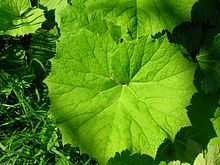Petasites hybridus
| Petasites hybridus | |
|---|---|
 | |
| Inflorescences | |
 | |
| Foliage | |
| Scientific classification | |
| Kingdom: | Plantae |
| (unranked): | Angiosperms |
| (unranked): | Eudicots |
| (unranked): | Asterids |
| Order: | Asterales |
| Family: | Asteraceae |
| Tribe: | Senecioneae |
| Genus: | Petasites |
| Species: | P. hybridus |
| Binomial name | |
| Petasites hybridus (L.) G.Gaertn., B.Mey. & Scherb. | |
| Synonyms | |
| |
Petasites hybridus, the (common) butterbur is a herbaceous perennial plant in the family Asteraceae, native to Europe and northern Asia. The flowers are produced in the early spring, before the leaves appear; they are pale pink, with several inflorescences clustered on a 5–20 cm stem. The leaves are large, on stout 80–120 cm tall stems, round, with a diameter of 40–70 cm. It is also called bog rhubarb, Devil's hat and pestilence wort. Synonyms include P. officinalis, P. ovatus and P. vulgaris.
Herbalism
Petasites hybridus leaves have been used in the traditional Austrian medicine internally (as tea or cold maceration in ethanol) and externally (as compresses or maceration in vinegar) for treatment of infections, fever, flu, and colds.[1]
The herbalist Nicholas Culpeper called it "a great preserver of the heart and reviver of the spirits". Its many uses in folk medicine include applications as a diuretic and muscle relaxant, and to treat coughs, fever, wounds, stammering, headaches, asthma and stress. Not all of these uses are supported by scientific research.
Potential medicinal uses
Preliminary trials have shown a preparation of Butterbur root to be effective in reducing the frequency and severity of migraine attacks.[2] A commercial extract Petasol butenoate complex (Ze 339) has proved helpful for allergic rhinitis[3][4] An evidence-based 2005 systematic review including written and statistical analysis of scientific literature, expert opinion, folkloric precedent, history, pharmacology, kinetics/dynamics, interactions, adverse effects, toxicology, and dosing is available from the Natural Standard Research Collaboration.[5]
References
- ↑ Sylvia Vogl, Paolo Picker, Judit Mihaly-Bison, Nanang Fakhrudin, Atanas G. Atanasov, Elke H. Heiss, Christoph Wawrosch, Gottfried Reznicek, Verena M. Dirsch, Johannes Saukel & Brigitte Koppa (2013). "Ethnopharmacological in vitro studies on Austria's folk medicine – an unexplored lore in vitro anti-inflammatory activities of 71 Austrian traditional herbal drugs". Journal of Ethnopharmacology 149 (3): 750–771. doi:10.1016/j.jep.2013.06.007. PMC 3791396. PMID 23770053.
- ↑ Taylor, Frederick R. (2011). "Nutraceuticals and Headache: The Biological Basis". Headache: the Journal of Head and Face Pain 51 (3): 484. doi:10.1111/j.1526-4610.2011.01847.x.
- ↑ Dumitru, Alina F.; Shamji, Mohamed; Wagenmann, Martin; Hindersin, Simone; Scheckenbach, Kathrin; Greve, Jens; Klenzner, Thomas; Hess, Lorenzo et al. (2011). "Petasol butenoate complex (Ze 339) relieves allergic rhinitis–induced nasal obstruction more effectively than desloratadine". Journal of Allergy and Clinical Immunology 127 (6): 1515–21.e6. doi:10.1016/j.jaci.2011.02.045. PMID 21489609.
- ↑ Dumitru, AF; Shamji, M; Wagenmann, M; Hindersin, S; Scheckenbach, K; Greve, J; Klenzner, T; Hess, L et al. (2011). "Petasol butenoate complex (Ze 339) relieves allergic rhinitis-induced nasal obstruction more effectively than desloratadine". The Journal of allergy and clinical immunology 127 (6): 1515–21.e6. doi:10.1016/j.jaci.2011.02.045. PMID 21489609.
- ↑ Giles M., Ulbricht C., Khalsa K.P.S., DeFranco Kirkwood C., Park C., Basch E., "Butterbur: An evidence-based systematic review by the natural standard research collaboration Journal of Herbal Pharmacotherapy 2005 5:3 (119-143
External links
 Media related to Petasites hybridus at Wikimedia Commons
Media related to Petasites hybridus at Wikimedia Commons